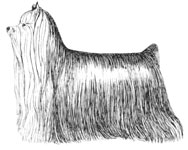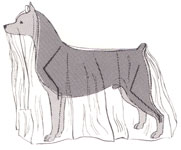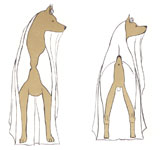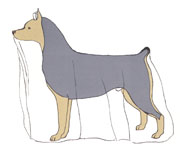
The Standard for the Yorkshire Terrier as defined by the Yorkshire Terrier Club of America and adhered to by the American Kennel Club is the guide by which the breed is defined unto itself and seperate from another breed. "...there was discussion ...about the need for revision of our Standard. We came to the conclusion that the present standard is a good one; what was needed more than a new standard was a clarification of our present one. " Anne H Goldman, Education Chair, YTCA 1979
When taken in combination with the history of the breed and the general concept that the Yorkie is a dog of NO EXTREMES, the Standard becomes very clear and well written. The Illustrated Discussion of The Yorkshire Terrier complete with pictures and guideline from its first publication in 1979 is an excellent 31 page booklet available upon request from the YTCA Secretary and should be read by every breeder, exhibitor, and judge of the breed.
Here, excerpts are taken for the education of the general reader for a better understanding of those illusive qualities of the breed.
General Appearance
 That of a long-haired toy terrier whose blue and tan coat is parted on
the face and from the base of the skull to the end of the tail and hangs
evenly and quite straight down each side of the body. The body is neat,
compact and well proportioned. The dog’s high head carriage and confident
manner should give the appearance of vigor and self-importance.
That of a long-haired toy terrier whose blue and tan coat is parted on
the face and from the base of the skull to the end of the tail and hangs
evenly and quite straight down each side of the body. The body is neat,
compact and well proportioned. The dog’s high head carriage and confident
manner should give the appearance of vigor and self-importance.
Discussion: ….a well balanced, neat, small, long coated Toy Terrier, readily identified by his straight, flowing silky body coat of bright, shiny, lustrous steel blue and clear shaded golds…..he carries himself in a self confident, sparkling and vigorous manner.
Head
Small and rather flat on top, the skull not to prominent or round, the muzzle not too long, with the bite neither undershot nor overshot and teeth sound. Either scissors bite or level bite is acceptable. The nose is black. Eyes are medium in size and not too prominent: dark in color and sparkling with a sharp intelligent expression. Eye rims are dark. Ears are small, V-shaped carried erect and set not too far apart.
Discussion: ….the correct head is always pleasing to the eye….with a large head, balance and breed type are lost…. Ideally the muzzle is set on at a 90 degree angle to the head forming the stop or “step”....The ideal length and breadth of the muzzle has jaws that are capable of supporting a full set of teeth with the proper bite….A dog whose nose is not black lacks pigmentation, a serious heredity fault….scissor bite preferred…Oval shaped eyes are preferred. A terrier’s eyes looks straight ahead which plays a major part in his expression. The eye fits well into the socket, never protruding or sunken….Low set ears detract from expression and are as highly undesirable as ears that are too large, rounded on tips, bat –shaped or set too wide….Movement of ears is very important to expression.
Body
 Well proportioned and very compact. The back is rather short, the
back line level, with height at shoulder the same as at the rump.
Well proportioned and very compact. The back is rather short, the
back line level, with height at shoulder the same as at the rump.
Discussion:…The neck is a definite separate entity dividing the Yorkies’s head and shoulders and adds to the dog’s overall elegance and style….Yorkshire Terrier breeders want a compact, well bodied animal with a good spring of rib and adequate depth of brisket and forechest for heart and lung capacity. Overly long bodies or exaggerated short ones are both undesirable. The ideal spring of rib is oval in shape with a gradual rounding toward the base and is sufficient depth to meet the Yorkie’s elbows.
Legs and Feet
 Forelegs should be straight, elbows neither in nor out. Hind legs straight
when viewed from behind, but stifles are moderately bent when viewed from
the sides. Feet are round with black toenails. Dewclaws, if any, are generally
removed from the hind legs. Dewclaws on the forelegs may be removed.
Forelegs should be straight, elbows neither in nor out. Hind legs straight
when viewed from behind, but stifles are moderately bent when viewed from
the sides. Feet are round with black toenails. Dewclaws, if any, are generally
removed from the hind legs. Dewclaws on the forelegs may be removed.
Discussion: …ideally, the Yorkshire’s shoulders are flat when viewed from the top, and somewhat sloping. When viewed from the side, the forelegs are strait, with elbows close to the rib cage. The pasterns are strong and straight. The feet are round, tight, cat-like with thick pads…with lower forelegs toeing out slightly….When viewing the body form the top, there is no evidence of pear-shaping; the breadth at the point of the shoulder is the same as the breadth at the point of the pelvis. The Yorkie has a moderate bend at the stifles when viewed from the side. The hock joint to the foot is perpendicular when the dog is standing still….angulation of hindquarters balances that of forequarters.
Tail
Docked to a medium length and carried slightly higher than the level of the back.
Discussion:….the croup is short and straight…the proper set-on of the tail is a continuation of the spine that comes off the same level as the back. However, many Yorkies cary their tails in an upright position while gaiting, which is allowed…the tail is docked at the point where the tan vent on the underside and the black (which extends to the end)meet. A yorkie with too short or too long a tail dock should not be penalized on that basis alone since it is a man-made fault.
Discussion Movement: The Yorkshire Terrier is a trotter. The motion is harmonious, smooth, sure and jaunty with the typical air of self-importance and vigor. He moves in a straight line with free and easy strides.
Coat
Quality, texture and quantity of coat are of prime importance. Hair is glossy, fine and silky in texture. Coat on the body moderately long and perfectly straight (not wavy). It may be trimmed to floor length to give ease of movement and a neater appearance, if desired. The fall on the head is long, tied with one bow in center or parted in the middle and tied with two bows. Hair on muzzle is very long. Hair should be trimmed short on tips of ears and may be trimmed on feet to give them a neat appearance.
Discussion: …The ideal coat texture is never coarse or brittle, nor is it ever wool or cottony to the touch…any evidence of an undercoat is undesirable… when a natural bristle brush is used on a clean, fully coated adult Yorkshire Terrier carrying the proper coat texture, every hair will rise and flow back into place. Every stand of hair on the proper texture coat appears to be individual.
Colors
Puppies are born black and tan and are normally darker in body color, show an intermingling of black hair in the tan until they are matured. Color of hair on body and richness of tan on head and legs are of prime importance in adult dogs, to which the following color requirements apply:
 Blue
Blue
Is a dark steel blue, not a silver blue and not mingled with fawn, bronze or black hairs.
Tan
All tan hair is darker at the roots than in the middle, shading to still lighter tan at the tips.
There should be no sooty or black hair intermingled with any of the tan.
Color on the body
The blue extends over the body from the back of the neck to root of tail.
Hair on tail is a darker blue, especially at end of tail.
Headfall
A rich golden tan, deeper in color at sides of head, at ear roots and on the muzzle, with ears a deep rich tan.
Tan color should not extend down on back of neck.
Chest and Legs
A bright, rich tan, not extending above the elbow on the forelegs nor above the stifle on the hind legs.
Discussion: Our breed is a difficult one in that it demands two very different and distinct METALLIC colors on a coat that is of a LUSTROUS silky texture...The coat texture, quality and quantity as well as its colors are of equal and of prime importance. The proper coat texture and colors always reflect a certain amount of brilliance and light naturally, and feel cool to the touch….On an adult Yorkie we desire an even, uniform, silky texured body coat of MEDIUM dark bright steel blue. Many of the so-called "dark steel blue" Yorkies are specimens nearer black in appearance and have coat quality and texture deviating from the Standard. We rarely find these animals FULLY BROKEN in body color at all partings fo the body even at two to three years of age, since these very black appearing coats can never trun or break to the desired true blue as speciied in the standard…A Yorkshire Terrier has a shaded tan (GOLD).. It is a BRIGHT, RICH, GLEAMING, BRILLIANT GOLDEN HUE, and will reflect light… likened to a NEW GOLD COIN. It bear no semblance to a rust, ginger or brownish mahogany hue…It is completely clear of any remaining black or sooty gray hair left from puppy hood.
NOTE: Coat texture, quality and quantity and its color are of equal and of prime importance, and any of the blue shads are ALWAYS preferable to black. Breeders are aware that both the dark blue and the light blue Yorkshire Terriers are needed in their breeding program.
Mention must be made that occasionally a Yorkie puppy will be vorn with small whie chest marks and perhaps a few white hairs located on the lower forejaw. It is unusualto find these tiny white marks visible on the adult; however, any lard amounts of white markings are highly undesirable, and the animal will generally maintain these patches of unwanted ahir thoroughout his liftime.
Weight
Must not exceed seven pounds.
Discussion: The Yorkie is a toy terrier, therefore any semblance of coarseness destroys breed type. The Yorkie which appears overly large or has the slightest trace of coarseness is highly undesirable as that Yorkshire lacks breed type.
Disqualification
Any solid color or combination of colors other than blue and tan as described above. Any white markings other than a small white spot on the forechest that does not exceed 1 inch at its longest dimension.
Approved April 12, 1966. Approved Addition of DQ October 1, 2007
Letter to the Judges for Disqualification Clarification
TO: AKC Judges, AKC Judging Operations
FROM: Yorkshire Terrier Club of America Board of Directors
DATE: September 26, 2007
SUBJECT: Clarification of the Yorkshire Terrier DQ to be initiated on October 1, 2007
The Disqualification reads as follows:
Any solid color or combination of colors other than blue and tan as described above. Any white markings other than a small white spot on the forechest that does not exceed 1 inch at its longest dimension.
DIRECTIVE;
The new Disqualification is an ADDITION to the Yorkshire Terrier Breed Standard. It is there to disqualify Yorkshire Terriers with colors OTHER THAN those as described in our Breed Standard. The American Kennel Club is registering parti-colors, solid colors, and chocolate and tan dogs as Yorkshire Terriers even though they do not meet our Breed Standard as written. AKC will not deny registration on color alone. These dogs have been shown at AKC matches and non-AKC events. Immature dogs not having a totally clear tan or immature dogs that are not yet totally blue are acceptable under our Breed Standard and should NOT be disqualified. To do so would be a misinterpretation of the Disqualification AND of the Breed Standard.
The Yorkshire Terrier whose coat is of prime importance has a slow metamorphosis from the black and tan puppy to the blue and tan adult. Some of these dogs take three or more years for their coat to mature; therefore our YTCA Members chose NOT to specify an age for color maturity. Only dogs of solid color, unusual combination of colors, and parti-colors should be disqualified.
In summary:
DISQUALIFY
- Solid color dogs such as a solid color gold or solid color chocolate
- A chocolate and tan dog or other unusual combination of colors
- A white dog with black and tan markings (parti-color)
DO NOT DISQUALIFY
- Puppies, Class dogs and young Champions whose tan has not yet totally cleared. This is typically seen around the head area where thumb prints may exist. Young Puppies may still have an intermingling of black hair in the tan.
- Puppies and young adults whose black body coat has not yet totally turned to blue.
- A dog that has a small white spot not to exceed 1 inch on the fore-chest.
A Blueprint or Guide (Illustrated Discussion) as to what the Parent Club considers to be the correct Yorkshire Terrier can be obtained by contacting the club secretary.(Address above) You may also check our website YTCA.ORG (with frames) under Judges Education.
